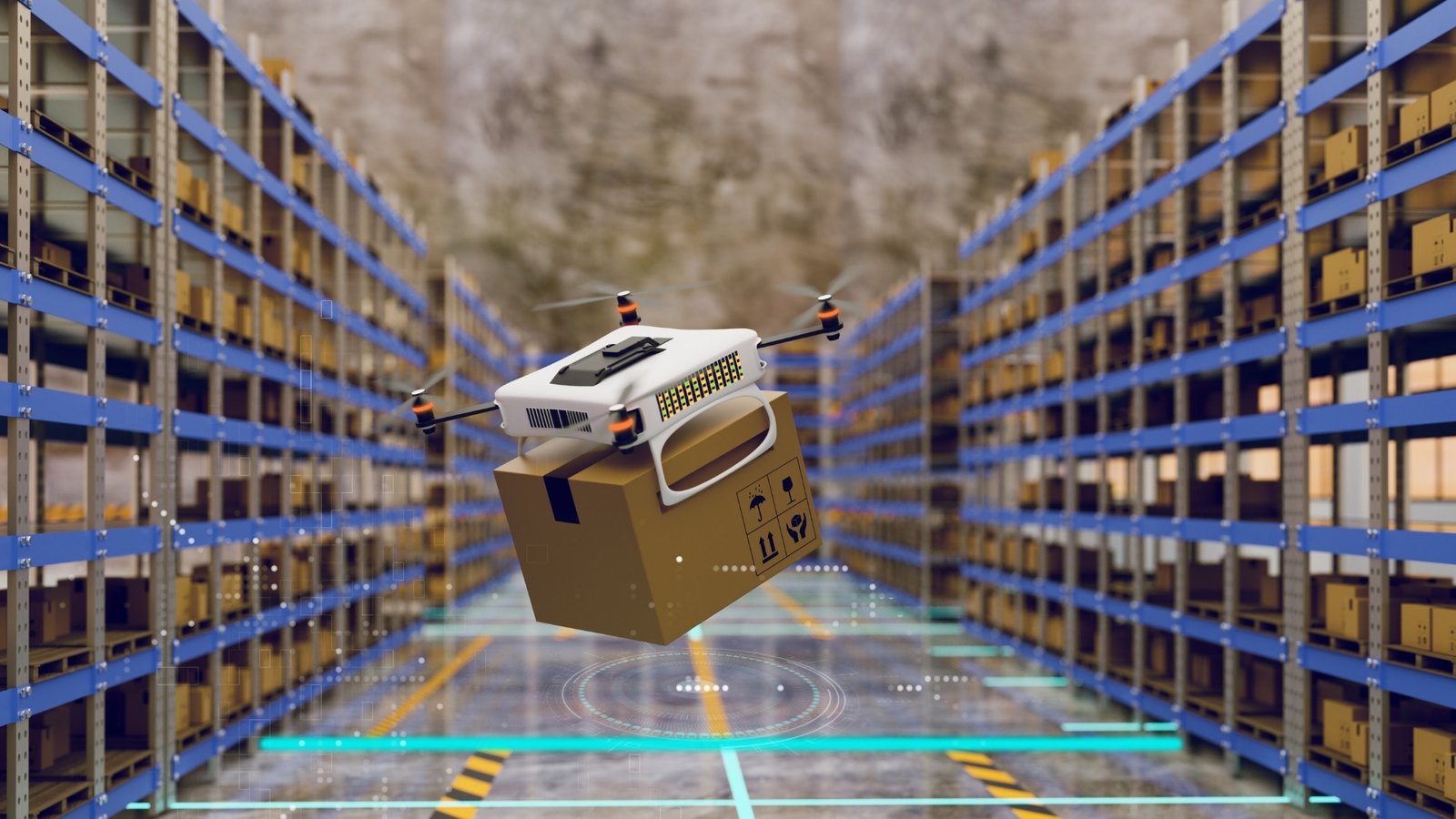Introduction to Warehousing Evolution
The evolution of warehousing has been a transformative journey, reflecting the ongoing changes in technology, consumer behavior, and supply chain dynamics. Historically, warehouses served as simple storage spaces where goods were stored until needed. However, the rise of global trade and advances in logistics have redefined this traditional model, leading to a more integrated approach to inventory management and distribution.
One significant driver of change has been the emergence of e-commerce. With an increasing number of consumers opting for online shopping, the demand for efficient warehousing solutions has skyrocketed. Retailers are now faced with the necessity to fulfill orders more swiftly, leading to the adoption of automated systems, advanced inventory management software, and real-time tracking capabilities. These innovations not only streamline operations but also enhance customer satisfaction by reducing lead times.
Additionally, the expectations for how quickly a product can be delivered have evolved significantly. The concept of same-day and next-day delivery has become prevalent, placing enormous pressure on warehousing operations to be more adaptive and responsive. This shift has prompted many organizations to rethink their warehousing strategies, prompting the exploration of urban distribution centers and multi-channel fulfillment systems to enhance accessibility and reduce delivery times.
Milestones in warehouse management, such as the introduction of the first mechanized conveyor belts in the early 20th century and the advent of barcoding technology in the 1970s, have laid essential groundwork for today’s sophisticated operations. The continuous pursuit of innovation remains vital as the warehousing industry looks towards the future, where trends such as artificial intelligence, robotics, and sustainability practices are poised to reshape how goods are stored and distributed.
Automation and Robotics in Warehousing
The warehousing industry is experiencing a significant transformation driven by advancements in automation and robotics. These innovations are reshaping how goods are stored, retrieved, and managed within distribution centers. Among the most notable developments are Automated Guided Vehicles (AGVs) and robotic picking systems, which streamline numerous processes and enhance operational efficiency.
Automated Guided Vehicles have emerged as a vital tool in modern warehousing. These self-navigating machines facilitate the transportation of goods within the warehouse, minimizing human intervention and reducing the chances of errors during material handling. As a result, companies that implement AGVs can achieve a considerable increase in throughput, significantly reducing operational time. The integration of AGVs not only ensures higher efficiency but also contributes to improved safety conditions by limiting the potential for workplace accidents.
Robotic picking systems represent another significant innovation changing the warehouse landscape. These systems are designed to automate the selection and packaging of products for shipment. Utilizing advanced technologies such as computer vision and artificial intelligence, these robots can accurately identify and handle a variety of items, adapting to different product sizes and shapes. This adaptability allows for the optimization of space and resources, which can lead to cost reductions associated with labor and overhead.
Several companies have successfully adopted these technologies, showcasing their transformative potential. For instance, large retailers have implemented robotic solutions to manage inventory levels efficiently and improve order fulfillment times. The integration of automation and robotics not only supports labor efficiencies but also enables warehouses to remain competitive in a fast-paced logistics environment.
Overall, the rise of automation and robotics is pivotal to shaping the future of warehousing. By embracing these technological advancements, companies stand to benefit from enhanced efficiency, reduced labor costs, and improved safety measures, paving the way for a more effective supply chain ecosystem.
The Role of Artificial Intelligence and Machine Learning
Artificial intelligence (AI) and machine learning (ML) have emerged as transformative forces in the warehousing industry, enabling more efficient and insightful operations. The integration of AI technologies into warehousing practices allows businesses to optimize their processes, leading to enhanced decision-making and improved operational efficiency. One crucial application of AI in warehousing is predictive analytics, which aids in inventory management and demand forecasting.
Predictive analytics relies on historical data to inform future inventory needs, helping warehouses maintain optimal stock levels and reduce excess inventory. By utilizing machine learning algorithms, warehouses can analyze vast amounts of data, identifying patterns that human analysts might overlook. This not only ensures that products are available when needed but also minimizes the costs associated with overstocking. As a result, businesses experience improved cash flow and customer satisfaction.
Another innovation driven by AI and machine learning is the optimization of storage space. With advanced algorithms, warehouses can better understand their storage capacities and arrange inventory layouts effectively. By analyzing the frequency of product turnover, AI can suggest ideal locations for goods within the warehouse, thereby streamlining picking processes and reducing the time employees spend searching for items. This space optimization ultimately leads to lower operational costs and increased throughput.
Case studies illustrate the effectiveness of AI and ML in warehousing environments. For instance, a prominent logistics company implemented an AI-driven inventory management system that reduced stock discrepancies by 30% within a year. Similarly, predictive analytics tools allowed another major retailer to forecast demand with 95% accuracy, significantly improving their service levels during peak seasons. These examples highlight the considerable impact that artificial intelligence and machine learning can have on shaping the future of warehousing.
Sustainability in Warehousing: A Growing Priority
The warehousing industry is undergoing a significant transformation, with sustainability emerging as a crucial focus for companies worldwide. As climate change concerns rise and regulatory frameworks tighten, warehouses are increasingly recognizing their role in reducing environmental impacts. This shift is marked by the adoption of eco-friendly materials and practices that align with broader corporate sustainability goals.
One notable trend is the use of sustainable building materials in the construction and renovation of warehouse facilities. Manufacturers and operators are increasingly favoring materials such as recycled steel, reclaimed wood, and low-VOC (volatile organic compound) products that minimize the carbon footprint of their operations. Such changes not only help reduce waste but also contribute to the creation of healthier working environments.
Energy efficiency is another key aspect of sustainability within warehousing. Companies are harnessing advanced technologies such as automated lighting systems, energy-efficient HVAC systems, and solar panels to lower energy consumption. For instance, companies like Amazon have invested heavily in renewable energy, with several of their warehouses powered by solar energy. This not only reduces operating costs but also enhances the overall sustainability of their supply chain.
Moreover, waste reduction strategies are becoming more prevalent in warehouse operations. Implementing recycling programs and exploring composting options are just a few of the initiatives being adopted. Some companies are also focusing on reverse logistics, which aims to minimize waste through the reuse and recycling of packaging materials. This holistic approach not only supports sustainability efforts but also drives operational efficiencies.
In conclusion, the ongoing emphasis on sustainability in warehousing is reshaping the industry landscape. Companies that pioneer eco-friendly practices not only benefit from cost savings and regulatory compliance but also enhance their brand reputation in an increasingly environmentally conscious marketplace. As these trends continue to grow, the warehousing sector is likely to see further innovations that prioritize sustainability.
The Rise of Omnichannel Distribution
The advent of ecommerce has transformed consumer expectations, leading to the emergence of omnichannel distribution as a vital strategy for modern retailers. Omnichannel distribution refers to a seamless approach to shopping, where customers can interact with a brand through multiple channels—physical stores, online platforms, or mobile apps—while enjoying consistent pricing, product availability, and communication. As consumers increasingly demand integrated experiences, warehouses must evolve to accommodate both online and offline orders effectively.
To address this shift, warehouses are adopting innovative solutions that facilitate the efficient fulfillment of orders across various channels. This includes the implementation of advanced technologies such as artificial intelligence (AI), big data analytics, and the Internet of Things (IoT). These tools enable facilities to optimize inventory management, ensuring that they have the right products in the right locations at any given time. However, the transition to an omnichannel distribution model presents several challenges, particularly in inventory management.
One of the primary challenges is maintaining real-time visibility across all distribution channels. With consumers expecting rapid fulfillment times, warehouses must refine their inventory tracking systems to prevent stockouts and overstock situations. Solutions such as demand forecasting and multi-location inventory management can significantly enhance efficiency. By utilizing data analytics, warehouses can predict consumer buying patterns and adjust their inventories accordingly, thereby meeting the omnichannel demands without incurring excessive costs.
Moreover, collaboration between logistics and retail operations is essential in overcoming these hurdles. By fostering interdepartmental communication, businesses can ensure that their warehousing strategies align with overall sales objectives, leading to optimized performance. The rise of omnichannel distribution signifies a pivotal shift in warehousing, prompting companies to rethink traditional practices and invest in technologies that streamline operations and elevate customer satisfaction.
Data-Driven Warehousing: The Power of Analytics
In recent years, data analytics has emerged as a transformative force within the warehousing sector, fundamentally altering how operations are conducted. The integration of data analytics into warehouse management allows businesses to harness big data, enabling them to gain valuable insights that were previously unattainable. By leveraging this wealth of information, companies are now able to enhance business intelligence and make informed decisions that promote efficiency and profitability.
One of the primary applications of data analytics in warehousing is in inventory tracking. Advanced analytics tools provide real-time visibility into stock levels, helping businesses optimize inventory management. This capability reduces the costs associated with overstocking or stockouts, thereby improving customer satisfaction and operational efficiency. For instance, predictive analytics can forecast demand trends based on historical data, allowing for better alignment of inventory levels with expected sales.
Additionally, data analytics plays a pivotal role in streamlining operations by assessing workflow efficiencies. Logistics managers can utilize analytical software to identify bottlenecks in the supply chain, optimize pick paths in warehouses, and schedule staff more effectively. Tools like Warehouse Management Systems (WMS) and Inventory Optimization Software have revolutionized how data is utilized in warehousing, giving managers actionable insights into labor allocation and storage density.
Moreover, integrating data analytics with emerging technologies like the Internet of Things (IoT) and artificial intelligence (AI) is propelling warehousing innovations to new heights. IoT devices provide continuous data streams from equipment and inventory, which AI can analyze to uncover patterns and suggest improvements. The combination of these technologies not only enhances operational capabilities but also supports strategic planning and long-term growth.
In conclusion, data-driven warehousing is revolutionizing the industry by utilizing advanced analytics to improve inventory tracking, streamline operations, and enhance overall business intelligence. As more organizations recognize the power of data, the trend toward data-centric practices is likely to persist, shaping the future of warehousing in profound ways.
Decentralization and Micro-Warehousing
The concept of decentralization in warehousing has gained significant attention in recent years, driven primarily by the need for flexibility and efficiency within supply chain operations. Micro-warehousing, a model that involves establishing smaller-scale warehouses in urban areas, has emerged as a viable solution to address the growing demand for rapid delivery and reduced logistical complexities. This shift is influenced by several factors, including the rise of e-commerce, changing consumer preferences, and advancements in technology.
Micro-warehousing facilities are strategically located closer to consumers, enabling businesses to fulfill orders more quickly while minimizing transportation costs. These decentralized warehouses can range from repurposed retail spaces to small, dedicated facilities that cater to specific neighborhoods. The proximity to customers not only improves delivery speeds but also enhances overall customer satisfaction. In an era where consumers expect quicker service, the micro-warehousing model can significantly elevate a brand’s competitive edge.
However, the rise of micro-warehousing is not without its challenges. Businesses must carefully consider factors such as inventory management, operational efficiencies, and the potential for increased overhead associated with maintaining multiple locations. Integrating technology into these small-scale operations can help streamline processes and reduce costs, but it requires upfront investment and ongoing management. Additionally, organizations must navigate complex regulatory requirements that may differ from one urban area to another.
Looking ahead, the trend of decentralization and micro-warehousing is expected to continue evolving. As more companies recognize the benefits of this model, we can anticipate a growing number of collaborations between businesses and technology providers. Innovations in logistics and supply chain management software will likely play a vital role in enabling effective micro-warehousing strategies, ultimately shaping the future of warehousing as we know it. This decentralized approach holds the promise of not only improving efficiency but also contributing to sustainability goals within the supply chain sector.
The Impact of the Internet of Things (IoT)
The Internet of Things (IoT) has emerged as a transformative force in the warehousing industry, significantly enhancing operational efficiency and safety. By integrating IoT sensors into warehouse operations, businesses can achieve real-time monitoring of inventory and equipment, as well as environmental conditions. These sensors collect and transmit data regarding stock levels, machinery status, and climate factors, providing valuable insights that facilitate informed decision-making.
One of the most notable advantages of IoT implementation in warehousing is the ability to maintain accurate inventory records. Automated tracking systems equipped with IoT sensors can alert warehouse managers to stock shortages or discrepancies immediately, minimizing the risks of overstocking or stockouts. This level of visibility allows for a more responsive supply chain, ensuring that products are available when needed and reducing holding costs associated with excess inventory.
Additionally, IoT sensors can monitor the performance and health of equipment, leading to proactive maintenance schedules. By identifying potential issues before they escalate into costly breakdowns, warehouses can optimize their operations and avoid disruptions. This not only extends the lifespan of machinery but also enhances overall safety in the workplace, as well-maintained equipment is less likely to pose hazards to employees.
Environmental conditions within warehouses also benefit from IoT technology. Sensors can monitor temperature, humidity, and air quality, ensuring that sensitive products are stored under optimal conditions. By automating environmental monitoring, warehouses can comply with regulatory requirements and preserve the integrity of their products, thereby mitigating losses and enhancing customer satisfaction.
In summary, the integration of IoT into warehousing is revolutionizing the industry by improving inventory accuracy, streamlining maintenance processes, and creating safer, more efficient environments for operations. The impact of such technologies is likely to continue shaping the future landscape of warehousing for years to come.
Conclusion: Preparing for the Future of Warehousing
As we navigate the evolving landscape of logistics and supply chain management, the future of warehousing is shaped by significant trends and innovations. The ongoing advancements in automation, artificial intelligence, and the Internet of Things are transforming traditional storage facilities into smart, data-driven environments. Warehouse operators must be adept at integrating these technologies to streamline operations and boost efficiency. The shift toward automated systems not only reduces the reliance on manual labor but also optimizes inventory management while minimizing errors.
Flexibility has emerged as a vital component in modern warehousing. With consumer demands fluctuating rapidly, the ability to adapt space and processes is crucial. This encompasses the implementation of agile logistics practices, enabling warehouses to handle varying product volumes and types without extensive downtime. Additionally, the rise of e-commerce necessitates a strategic approach to last-mile delivery services, further reinforcing the importance of flexibility in warehouse operations.
Sustainability is another pressing factor influencing the future of the warehousing sector. As environmental regulations become more stringent, warehouse operators are increasingly focusing on eco-friendly practices. This includes the adoption of green building designs, energy-efficient systems, and waste-reduction strategies. Implementing sustainable practices not only meets compliance requirements but also appeals to environmentally conscious consumers, thereby enhancing brand reputation and loyalty.
Looking ahead, further innovations, such as advanced robotics and blockchain technology, are expected to play significant roles in transforming warehouse operations. These developments may lead to greater efficiencies and security within the supply chain. By proactively adopting these new technologies, embracing flexibility, and prioritizing sustainability, warehouse operators can better prepare themselves for the challenges and opportunities that lie ahead in this dynamic industry.







